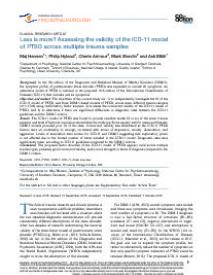Less is more? Assessing the validity of the ICD-11 model of PTSD across multiple trauma samples
Background: In the 5th edition of the Diagnostic and Statistical Manual of Mental Disorders (DSM-5), the symptom profile of posttraumatic stress disorder (PTSD) was expanded to include 20 symptoms. An alternative model of PTSD is outlined in the proposed 11th edition of the International Classification of Diseases (ICD-11) that includes just six symptoms.
Objectives and method: The objectives of the current study are: 1) to independently investigate the fit of the ICD-11 model of PTSD, and three DSM-5-based models of PTSD, across seven different trauma samples (N=3,746) using confirmatory factor analysis; 2) to assess the concurrent validity of the ICD-11 model of PTSD; and 3) to determine if there are significant differences in diagnostic rates between the ICD-11 guidelines and the DSM-5 criteria.
Results: The ICD-11 model of PTSD was found to provide excellent model fit in six of the seven trauma samples, and tests of factorial invariance showed that the model performs equally well for males and females. DSM-5 models provided poor fit of the data. Concurrent validity was established as the ICD-11 PTSD factors were all moderately to strongly correlated with scores of depression, anxiety, dissociation, and aggression. Levels of association were similar for ICD-11 and DSM-5 suggesting that explanatory power is not affected due to the limited number of items included in the ICD-11 model. Diagnostic rates were significantly lower according to ICD-11 guidelines compared to the DSM-5 criteria.
Conclusions: The proposed factor structure of the ICD-11 model of PTSD appears valid across multiple trauma types, possesses good concurrent validity, and is more stringent in terms of diagnosis compared to the DSM-5 criteria.
Geachte bezoeker,
De informatie die u nu opvraagt, kan door psychotraumanet niet aan u worden getoond. Dit kan verschillende redenen hebben,
waarvan (bescherming van het) auteursrecht de meeste voorkomende is. Wanneer het mogelijk is om u door te verwijzen naar de bron
van deze informatie, dan ziet u hier onder een link naar die plek.
Als er geen link staat, kunt u contact opnemen met de bibliotheek,
die u verder op weg kan helpen.
Met vriendelijke groet,
Het psychotraumanet-team.
Reference:
Maj Hansen, Philip Hyland, Cherie Armour, Mark Shevlin, & Ask Elklit | 2015
In: European journal of psychotraumatology, ISSN 2000-8066 | 6 | 28766
http://www.ejpt.net/index.php/ejpt/article/view/28766
In: European journal of psychotraumatology, ISSN 2000-8066 | 6 | 28766
http://www.ejpt.net/index.php/ejpt/article/view/28766


